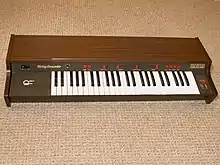String synthesizer
A string synthesizer or string machine is a specialized synthesizer designed specifically to make sounds similar to that of a string orchestra. Dedicated string synthesizers occupied a specific musical instrument niche between electronic organs and general-purpose synthesizers in the 1970s and early 1980s, until advances in digital signal processing technology allowed the production of inexpensive general-purpose polyphonic synthesizers and samplers, which made the existence of a separate type of instrument unnecessary.[1]

The development of the string synthesizer was originally motivated by the need for a cheaper and more portable alternative to the Mellotron, which was itself a cheaper alternative to human string ensembles.[2] The availability of string synthesizers was influential in adding string orchestration to popular music that would not otherwise be able to afford the use of a human string ensemble, and their characteristic sound, which was almost, but not quite, like that of a real string ensemble, was one of the distinguishing sounds of the era.
To keep costs down, string synthesizers typically used a frequency divider architecture similar to that of electronic organs, with the addition of specialized in-built vibrato and chorus effects to mimic the ensemble effect of multiple string instruments playing at once. Classic string synthesizers included the Freeman String Symphonizer, Eminent 310,[3] Logan String Melody, Roland RS-101, Roland RS-202,[4][5] Korg Polyphonic Ensemble S, Crumar Orchestrator (Multiman-S), Elka Rhapsody, ARP String Ensemble,[1] Moog Opus 3 and the Vox String Thing (a rebranded version of the budget Jen SM2007 String Machine) and the Roland VP-330.
See also
- Mellotron, an analog tape-replay keyboard also used to imitate string ensembles
References
- Laughton, Jay (21 March 2016). "A Brief History of String Synths". reverb.com. Retrieved 2016-09-27.
- Reid, Gordon (February 2007). "Ken Freeman & The Birth Of String Synthesis". Sound On Sound. Retrieved 2016-09-27.
- Reid, Gordon (May 2007). "Eminent 310 String Synthesizer". Sound On Sound. Retrieved 2016-09-27.
- Jenkins, Mark (2009). Analog Synthesizers: Understanding, Performing, Buying--From the Legacy of Moog to Software Synthesis. CRC Press. p. 89. ISBN 978-1-136-12278-1.
- A Tale of Two String Synths, Sound on Sound, July 2002